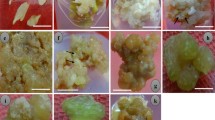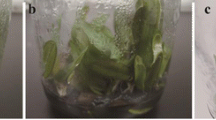Abstract
Physcomitrella patens is a model plant for studying gene function using a knockout strategy. To establish a proteome database for P. patens, we resolved over 1,500 soluble proteins from gametophore and protonema tissues by two-dimensional electrophoresis (2-DE) and obtained peptide mass fingerprints (PMFs) by matrix-assisted laser desorption/ionization-time of flight-mass spectrometry (MALDI-TOF-MS). Using expressed sequence tags (ESTs), we were able to predict the identities of 90 protein spots. Most of these were related to energy or primary metabolism. Comparative proteome analysis was used to identify proteins specific for each of the tissue types. One of these was a metallothionein type-2 (PpMT2) protein that was highly upregulated in gametophore tissue. PpMT2 was induced in both the gametophore and protonema following culture on solid media and in response to various abiotic stresses such as copper, cadmium, cold, indole-3-acetic acid, and ethylene. We suggest that PpMT2 is not only involved in metal binding and detoxification, but also in many biological aspects as a metal messenger or a protein with additional functions.






Similar content being viewed by others
References
Akashi K, Nishimura N, Ishida Y, Yokota A (2004) Potent hydroxyl radical-scavenging activity of drought-induced type-2 metallothionein in wild watermelon. Biochem Biophys Res Commun 323:72–78
Ashton NW, Cove DJ (1977) The isolation and preliminary characterisation of auxotrophic and analogue-resistant mutants of the moss, Physcomitrella patens. Mol Gen Genet 154:87–95
Charbonnel-Campaa L, Lauga B, Combes D (2000) Isolation of a type 2 metallothionein-like gene preferentially expressed in the tapetum in Zea mays. Gene 254:199–208
Cobbett C, Goldsbrough P (2002) Phytochelatins and metallothioneins: roles in heavy metal detoxification and homeostasis. Annu Rev Plant Biol 53:159–182
Cove D (2000) The Moss, Physcomitrella patens. J Plant Growth Regul 19:275–283
Finnie C, Melchior S, Roepstorff P, Svensson B (2002) Proteome analysis of grain filling and seed maturation in barley. Plant Physiol 129:1308–1319
Frank W, Ratnadewi D, Reski R (2005) Physcomitrella patens is highly tolerant against drought, salt and osmotic stress. Planta 220:384–394
Hamer DH (1986) Metallothionein. Annu Rev Biochem 55:913–951
Holstein SE (2002) Clathrin and plant endocytosis. Traffic 3:614–620
Imin N, Kerim T, Weinman JJ, Rolfe BG (2001) Characterisation of rice anther proteins expressed at the young microspore stage. Proteomics 1:1149–1161
Kersten B, Burkle L, Kuhn EJ, Giavalisco P, Konthur Z, Lueking A, Walter G, Eickhoff H, Schneider U (2002) Large-scale plant proteomics. Plant Mol Biol 48:133–141
Kim SI, Kim JY, Kim EA, Kwon KH, Kim KW, Cho K, Lee JH, Nam MH, Yang DC, Yoo JS, Park YM (2003) Proteome analysis of hairy root form Panax ginseng C. A. Meyer using peptide fingerprinting, internal sequencing and expressed sequence tag data. Proteomics 3:2379–2392
Lopez MF (1999) Proteome analysis. I. Gene products are where the biological action is. J Chromatogr B Biomed Sci Appl 722:191–202
Mathesius U, Keijzers G, Natera SH, Weinman JJ, Djordjevic MA, Rolfe BG (2001) Establishment of a root proteome reference map for the model legume Medicago truncatula using the expressed sequence tag database for peptide mass fingerprinting. Proteomics 1:1424–1440
Mir G, Domenech J, Huguet G, Guo WJ, Goldsbrough P, Atrian S, Molinas M (2004) A plant type 2 metallothionein (MT) from cork tissue responds to oxidative stress. J Exp Bot 55:2483–2493
Porubleva L, Vander Velden K, Kothari S, Oliver DJ, Chitnis PR (2001) The proteome of maize leaves: use of gene sequences and expressed sequence tag data for identification of proteins with peptide mass fingerprints. Electrophoresis 22:1724–1738
Rabilloud T, Adessi C, Giraudel A, Lunardi J (1997) Improvement of the solubilization of proteins in two-dimensional electrophoresis with immobilized pH gradients. Electrophoresis 18:307–316
Ramagli LS (1999) Quantifying protein in 2-D PAGE solubilization buffer. In: Link AJ (ed) 2-D proteome analysis protocol. Humana Press, Seattle, WA, pp 99–104
Rauser WE (1999) Structure and function of metal chelators produced by plants: the case for organic acids, amino acids, phytin, and metallothioneins. Cell Biochem Biophys 31:19–48
Reid SJ, Ross GS (1997) Up-regulation of two cDNA clones encoding metallothionein-like proteins in apple fruit during cool storage. Physiol Plant 100:183–189
Rensing SA, Rombauts S, Peer YV, Reski R (2002) Moss transcriptome and beyond. Trends Plant Sci 7:535–538
Reski R (1999) Molecular genetics of Physcomitrella. Planta 208:301–309
Reski R, Cove DJ (2004) Physcomitrella patens. Curr Biol 14:R261–262
Rodriguez FI, Esch JJ, Hall AE, Binder BM, Schaller GE, Bleecker AB (1999) A copper cofactor for the ethylene receptor ETR1 from Arabidopsis. Science 283:996–998
Sambrook J, Russell DW (2001) Molecular cloning, 3rd edn. Cold Spring Harbor Laboratory Press, New York
Sarnighausen E, Wurtz V, Heintz D, Dorsselaer AV, Reski R (2004) Mapping of the Physcomitrella patens proteome. Phytochemistry 65:1589–1607
Schaefer DG (2001) Gene targeting in Physcomitrella patens. Curr Opin Plant Biol 4:143–150
Schaefer DG, Zryd JP (2001) The moss Physcomitrella patens, now and then. Plant Physiol 127:1430–1438
Strepp R, Scholz S, Kruse S, Speth V, Reski R (1998) Plant nuclear gene knockout reveals a role in plastid division for the homolog of the bacterial cell division protein FtsZ, an ancestral tubulin. Proc Natl Acad Sci USA 95:4368–4373
Tsugita A, Kamo M. (1999) 2-D electrophoresis of plant proteins. In: Link AJ (ed) 2-D proteome analysis protocols. Humana Press, Seattle, WA, pp 95–98
van Hoof NA, Hassinen VH, Hakvoort HW, Ballintijn KF, Schat H, Verkleij JA, Ernst WH, Karenlampi SO, Tervahauta AI (2001) Enhanced copper tolerance in Silene vulgaris (Moench) Garcke populations from copper mines is associated with increased transcript levels of a 2b-type metallothionein gene. Plant Physiol 126:1519–1526
von Schwartzenberg K, Kruse S, Reski R, Moffatt B, Laloue M (1998) Cloning and characterization of an adenosine kinase from Physcomitrella involved in cytokinin metabolism. Plant J 13:249–257
Warwicker J (2001) Modelling of auxin-binding protein 1 suggests that its C-terminus and auxin could compete for a binding site that incorporates a metal ion and tryptophan residue 44. Planta 212:343–347
Watson BS, Asirvatham VS, Wang L, Sumner LW (2003) Mapping the proteome of barrel medic (Medicago truncatula). Plant Physiol 131:1104–1123
Zhou GK, Xu YF, Liu JY (2005) Characterization of a rice class II metallothionein gene: tissue expression patterns and induction in response to abiotic factors. J Plant Physiol 162:686–696
Acknowledgements
This work was supported by a grant from the BioGreen21 Program of the Rural Development Administration (to J.S.S.) and by the Korea Research Foundation Grant (MOEHRD, Basic Research Promotion Fund) (to S.H.C., no. M01-2004-000-10317-0). Sung Hyun Cho and Quoc Truong Hoang contributed equally to this study
Author information
Authors and Affiliations
Corresponding author
Additional information
Communicated by I.S. Chung
Rights and permissions
About this article
Cite this article
Cho, S.H., Hoang, Q.T., Kim, Y.Y. et al. Proteome analysis of gametophores identified a metallothionein involved in various abiotic stress responses in Physcomitrella patens . Plant Cell Rep 25, 475–488 (2006). https://doi.org/10.1007/s00299-005-0079-0
Received:
Revised:
Accepted:
Published:
Issue Date:
DOI: https://doi.org/10.1007/s00299-005-0079-0




